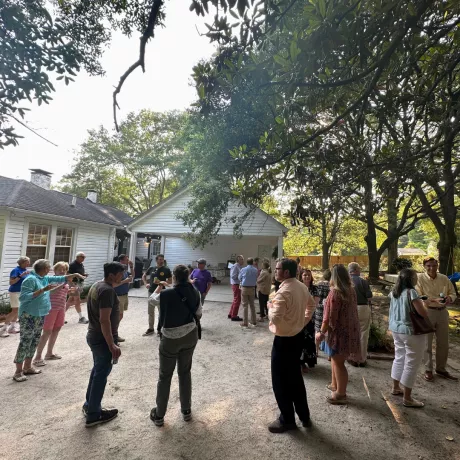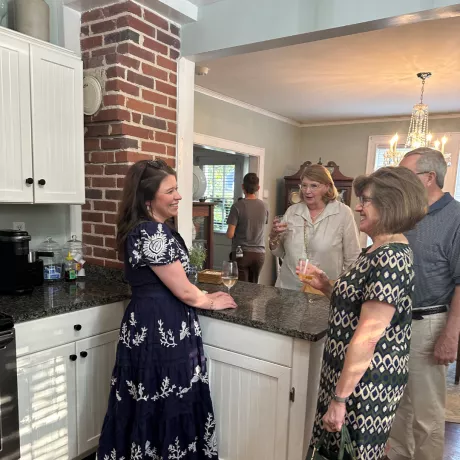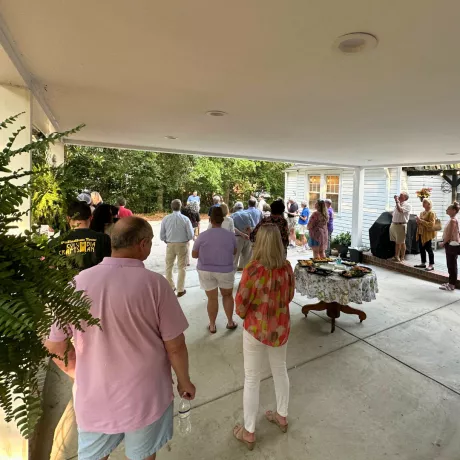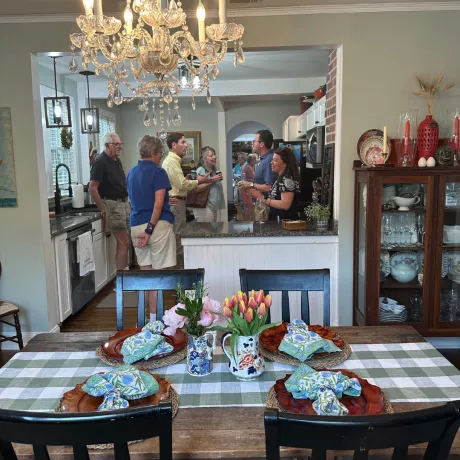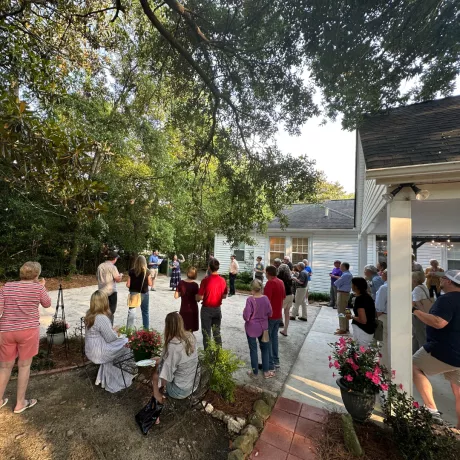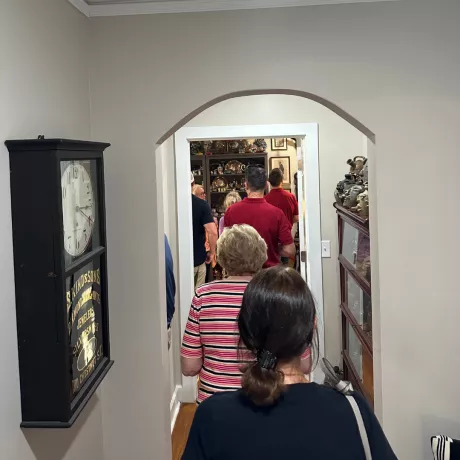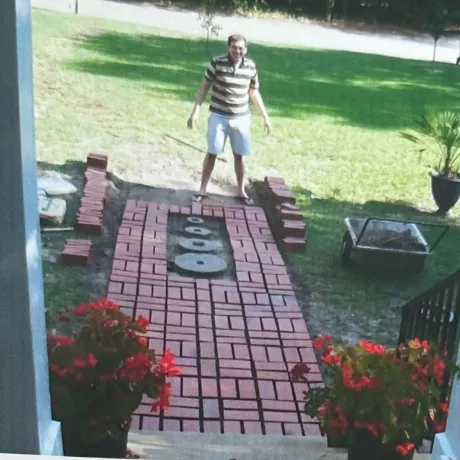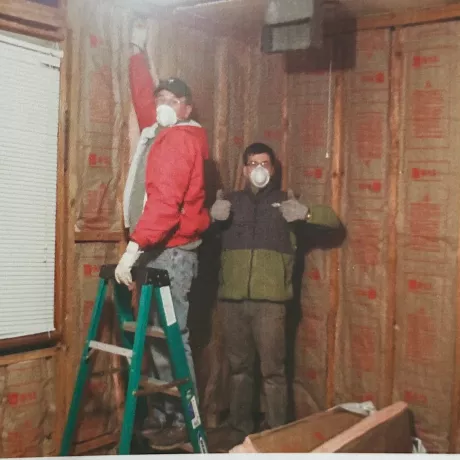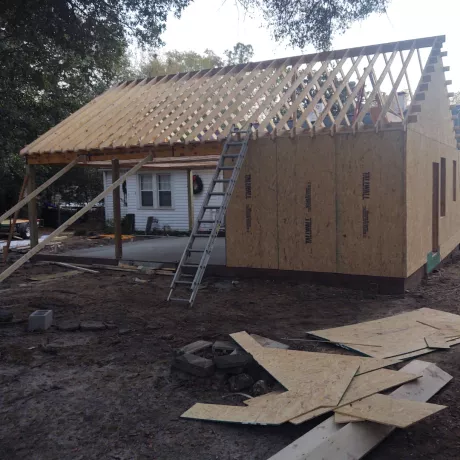Renovation Rodeo | Forest Acres
Thursday, June 8th 2023

Palladium presented Renovation Rodeo | Forest Acres on Thursday, June 8, from 6:00 - 7:30 p.m. Over 40 guests toured this home while enjoying beer from Steel Hands Brewing, wine courtesy of Republic National Distributing Company, and snacks. The homeowners, Matthew and Becky, spoke about the neighborhood and the home's history. This event was proudly sponsored by Abi Snyder with Geneva Financial and the Garvin Design Group.
Four times a year, Palladium features a property that has undergone—or is undergoing—a killer renovation. From tiny 1940s bungalows to turn-of-the-century mansions, and everything in between, these events give you a chance to tour properties, learn about their renovation, and have a great time doing it. And they're FREE for our Palladium members!
Neighborhood History
Neighborhood history is compiled from Forest Acres by Dr. Warner M. Montgomery:
Highlights
- In 1785, Thomas Taylor, Wade Hampton I, and Timothy Rives purchased 18,500 acres on both sides of Gill Creek. Taylor and Hampton bought out Rives and divided the land at Gills Creek, with Taylor on the East and Hampton on the West. Taylor sold the strip of land that houses the State Capital back to the state in 1786.
- The area was settled by farmers, entrepreneurs, developers, and finally suburbanites. Forest Acres was incorporated as a city in 1935 due to efforts of S.C. Senator James Henry Hammond (“town” of Quinine Hill) in collaboration with John Hughes Cooper (Forest Lake subdivision).
- The highest point in the city is Quinine Hill (253 feet in altitude).
“Quinine Hill”
The highest point on the Taylor property has a spring flowing from its sandy soil. In those days, a malaria medicine called quinine was being made from the bark of the South American cinchona tree. Since there was no standing water and few mosquitoes on the hill, a nephew of Taylor’s named it Quinine Hill to promote its healthy qualities.
John Francis Dalloz was the first settler on Quinine Hill. He served with Napoleon, was wounded at the Battle of Waterloo in 1815, and soon after immigrated to South Carolina, where he was employed by the Hamptons as a gardener.
He purchased land on Quinine Hill and planted grapevines and created a vineyard in the French style. His son John Francis Dalloz inherited the farm (adjacent street names). The Dalloz women were seamstresses to the wealthy women of Columbia.
After Columbia was founded on the Taylor plantations, Quinine Hill became a refuge from the summer heat and pesky mosquitoes. Several Taylor families, John Francis Dalloz, and Dr. James Davis (key figure in the development of the Bull Street Asylum) built summer retreats on the hill.
A brick and stone wall was constructed around the nearby spring at the corner of the Hammond and JB McLauchlin properties on Forest Drive. The “curative” water was offered free to all. (The spring was piped when Beltline Blvd was constructed in 1938 and runs below Richland Mall. As I recall, the Verizon Store on the corner of Beltline and Forest is built on top of the spring).
Hammond wanted all of his friends to move into his neighborhood and enjoy the trees, animals, and fresh air. He hired William “Bill” Hazelhurst, a civil engineer to survey the property in 1929 and lay out the streets. Several friends started to move in and on Christmas Day 1934 they elected officials for their small community. William Taylor became mayor. Names were given to the streets to reflect family connections; Senator Hammond’s mother was Laura Hanson.
Senator Hammond's property was cut in half by Beltline Blvd. On the Northwest corner of Beltline and Forest he built a commercial strip. His first tenant was Jim Scottins, who set up a drug store with a popular soda fountain. Hoover’s Gulf Station and Embers Drive-In soon followed. Hammond died in 1970 with no will and his property was sold to Zan Heyard and Bloomwood Development Company who developed it as a residential subdivision called Mill Pond.
Senator Hammond was eclectic; his pond house was made from old doors, windows, and planks from his razed office building in Columbia, and floorboards from the old Seibels house in Columbia. The pond house chandelier was made from antique guns, Indian axes, and old swords. Senator Hammond collected old millstones from the Taylor Mill on Gills Creek, which now line the streets of the Mill Pond development.
‘Forming Forest Acres’
Works Project Administration (WPA) money was used to form the city. Hammond and Cooper decided to combine their two towns (Quinine Hill and Forest Lake) to form one city to qualify for road improvement funds. On September 24, 1935, the town of Forest Acres was formed with a population of 375.
Forest Drive was widened in 1957, clearing the way for commercial development. Such developments included Richland Mall, built in 1961. Trenholm Plaza was developed on the old Monckton Golf Course property; the first tenants were Edisto Farms Dairy, Calvert-Brodie School of Dance, Roses 5 & Dime, Standard Building and Loan, and A&P Food Stores.

Home History
Architect - William Hazelhurst (may have designed several houses in neighborhood)
The home is a 2,000 square foot Colonial Revival Cape Cod style house, ca. 1940, with a side gabled roof, symmetrical dormers, and white horizontal lap siding. Traditionally, the Cape Cod style was native to the coastal northeast region of the country beginning in the 1600s, so the form responds to harsh nor'easter storm conditions. They were simple, flexible, starter homes, typically one story with a low horizontal presence, 2 windows on each side of a central entry door, and steep sloped side gabled roof, which sometimes allowed for a second story guestroom where seafarers could stay. The exterior would employ natural cedar shake siding, which would oxidize with the salt air into a silvery gray color. Newer adaptations of the Cape Cod style (Cape Cod Revival) can be accredited to architect Royal Barry Wills, whose reincarnated version kept the exterior features but modified the interior for modern function in the 1920s. Various versions of the style sprang up nationwide after World War II as people looked for low-cost, highly flexible housing. Levittown, NY was a famous planned suburban housing development that used assembly lines in the late 1940s to commoditize the Cape Cod style for mass consumption. Even the small houses used in the game Monopoly closely resemble the Cape Cod style.
Former Homeowners:
- Lucy Peet: 1950
- Miss Lucy Peet hosted cottage prayer meetings at her home at 3703 Hanson Ave in preparation for the Greater Columbia Evangelistic Crusade, which opened February 19, 1950 at the Township Auditorium. (State Newspaper)
- Dorothy Strauss (July 1, 1900 - August 11, 1974): 1953 - 1960
- Dorothy and Lucy were listed as occupants in the 1950 census. Dorothy was a religious teacher at the Bethel Bible Institute, which Lucy's listed occupation was "keeping house."
- Listed for rent in 1964-1965.
- Miss Billie Creighton (June 8, 1913 - October 8, 1983): 1970(?) - 1983
- The date of our Renovation Rodeo would have been her 110th birthday!
- 1940 Census data shows she was a stenographer and lived at 5505 Asylum Road in Hyatt Park.
- Buried in Elmwood Memorial Gardens.
- Listed for rent in 1998.
The above research was compiled by members of the Palladium Board education committee. Images courtesy of Matthew Morrison and Historic Columbia.
Enhance Our City
Palladium
Palladium members don't just learn about Columbia's past - they have a say in its future. Our fundraising events support Historic Columbia's important preservation and advocacy work, which in turn helps preserve the charm and vitality of the city we call home.
